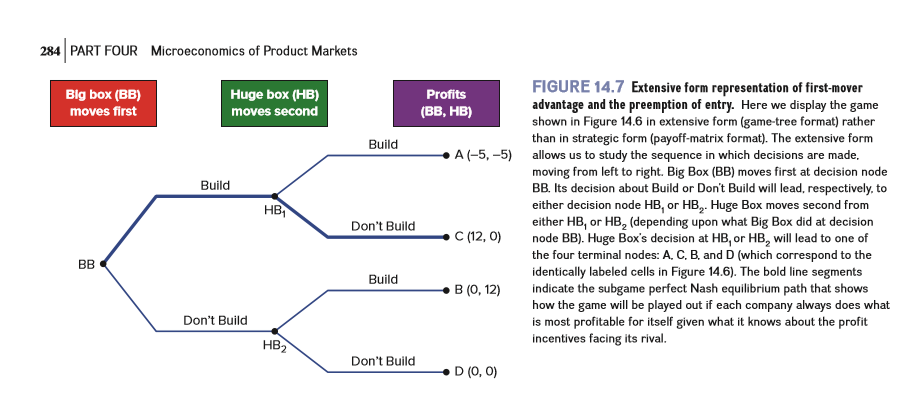284 PART FOUR Microeconomics of Product Markets FIGURE 14.7 Extensive form representation of first-mover advantage and the preemption of entry. Here we display the game shown in Figure 14.6 in extensive form (game-tree format) rather Big box (BB) Huge box (HB) Profits moves first moves second (BB, HB) than in strategic form (payoff-matrix format). The extensive form A (-5, -5) allows us to study the sequence in which decisions are made, moving from left to right. Big Box (BB) moves first at decision node BB. Its decision about Build or Don't Build will lead, respectively, to either decision node HB, or HB,. Huge Box moves second from either HB, or HB, (depending upon what Big Box did at decision node BB). Huge Box's decision at HB, or HB, will lead to one of the four terminal nodes: A. C, B, and D (which correspond to the Build Build HB 2' Don't Build C (12, 0) BB identically labeled cells in Figure 14.6). The bold line segments indicate the subgame perfect Nash equilibrium path that shows how the game will be played out if each company always does what is most profitable for itself given what it knows about the profit incentives facing its rival. Build B (0, 12) Don't Build HB2 Don't Build D (0, 0)
Critical Path Method
The critical path is the longest succession of tasks that has to be successfully completed to conclude a project entirely. The tasks involved in the sequence are called critical activities, as any task getting delayed will result in the whole project getting delayed. To determine the time duration of a project, the critical path has to be identified. The critical path method or CPM is used by project managers to evaluate the least amount of time required to finish each task with the least amount of delay.
Cost Analysis
The entire idea of cost of production or definition of production cost is applied corresponding or we can say that it is related to investment or money cost. Money cost or investment refers to any money expenditure which the firm or supplier or producer undertakes in purchasing or hiring factor of production or factor services.
Inventory Management
Inventory management is the process or system of handling all the goods that an organization owns. In simpler terms, inventory management deals with how a company orders, stores, and uses its goods.
Project Management
Project Management is all about management and optimum utilization of the resources in the best possible manner to develop the software as per the requirement of the client. Here the Project refers to the development of software to meet the end objective of the client by providing the required product or service within a specified Period of time and ensuring high quality. This can be done by managing all the available resources. In short, it can be defined as an application of knowledge, skills, tools, and techniques to meet the objective of the Project. It is the duty of a Project Manager to achieve the objective of the Project as per the specifications given by the client.
Look back at Figure. Suppose that the payouts at terminal node B change to (13,12) while everything else in the game stays the same. The new subgame perfect Nash equilibrium will consist of the two line segments:
a. Build at BB followed by Build at HB1.
b. Build at BB followed by Don’t Build at HB1.
c. Don’t Build at BB followed by Build at HB2.
d. Don’t Build at BB followed by Don’t Build at HB2.

Trending now
This is a popular solution!
Step by step
Solved in 2 steps









